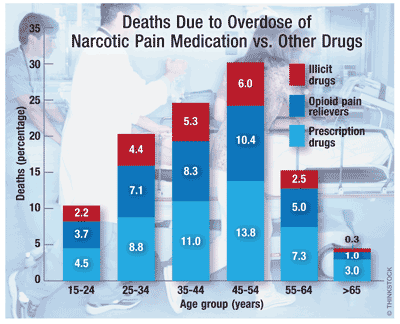US Pharm. 2014;39(3):26.
According to the Drug Abuse Warning Network, a public-health surveillance system, 49% of the 5.1 million drug-related emergency room (ER) visits (80% of patients adult, 48% male) made in 2011 were attributed to pharmaceutical misuse or abuse (1.4 million) and illicit drugs (1.3 million). Of visits for drug misuse or abuse, 82% of patients were adults, 56% of them were male, and 51% of cases involved a single drug. Oxycodone products were the narcotic pain relievers most commonly implicated during ER visits (175,229 visits, or 56.2 per 100,000 population). Hydrocodone, methadone, and morphine products followed oxycodone with 31.2, 24.3, and 12.3 visits per 100,000 population, respectively.

Methadone: Methadone is used to treat drug addiction and to relieve back pain. More than 4 million methadone prescriptions were written for pain in 2009. The difference in usage between those taking methadone for pain and those who died of methadone overdose is small (2.1 and 1.5 per 100,000 people, respectively). However, as the use of methadone use for pain has increased, nonmedical use and the number of overdoses have increased likewise. Although all prescription painkillers have contributed to an increase in overdose deaths, 30% of prescription painkiller deaths in 2009 involved methadone, a rate six times higher than that of a decade ago. About 5,000 people die each year of methadone-related overdose.
Mortality Statistics: Mortality rates for drug overdose have tripled since 1990. For every death, there are 10 treatment admissions for abuse, 32 ER visits for misuse or abuse, 130 individuals who abuse or are dependent, and 825 nonmedical users. Every year, nearly 15,000 people die from drug overdose, exceeding the number of those dying from heroin and cocaine combined. Drugs primarily responsible include prescription painkillers, specifically hydrocodone, methadone, oxycodone, and oxymorphone (collectively referred to as opioid pain relievers [OPRs]). In 2010, more than 16,000 people died of an OPR overdose. In 2009, 12 million (1 in 20) Americans misused or abused OPRs, contributing to about 250,000 ER visits and costing health insurers up to $72.5 billion annually in direct healthcare costs. Individuals more likely to overdose on OPRs are male (5.9 males vs. 3.7 females per 100,000), middle-aged (10.4 per 100,000), residents of rural counties, and non-Hispanic white (6.3 per 100,000), or Native American (6.2 per 100,000).
Misuse: Most prescription painkillers are prescribed by dentists and primary care and internal medicine physicians, but not specialists. Studies have shown that 80% of all prescription painkillers are prescribed by 20% of prescribers. Once OPRs are prescribed and dispensed for the treatment of a patient’s pain, 75% of these drugs are frequently used without a prescription by someone else.
To comment on this article, contact rdavidson@uspharmacist.com.





